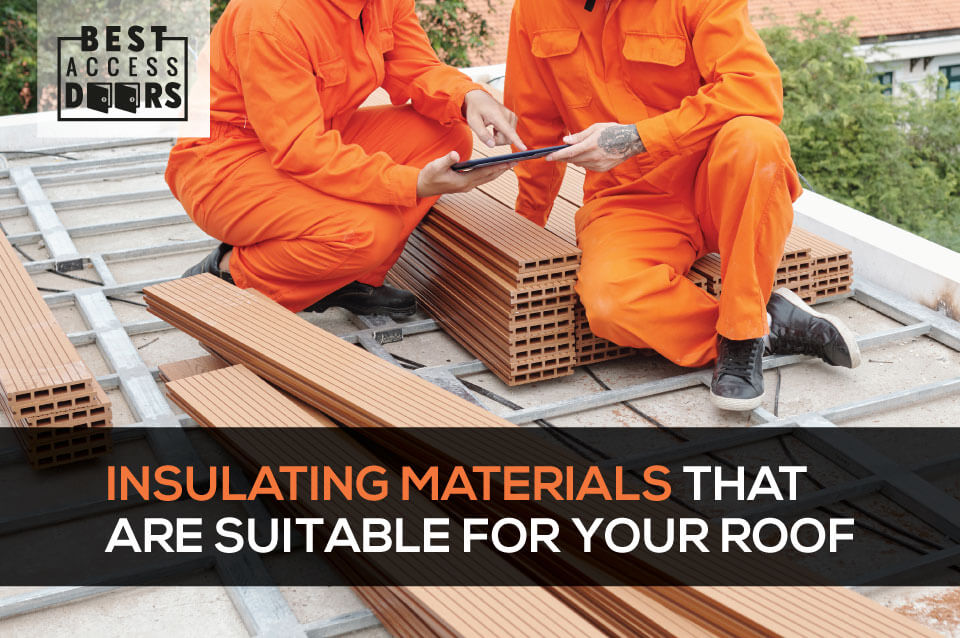Insulating Materials That Are Suitable For Your Roof
Posted by Best Access Doors on 22nd Dec 2021
Roof insulation is a vital component to maintain the temperature efficiency and comfort of your building. Besides that, roof insulation also helps cancel the noise coming from the busy streets outside your establishment.
The significance of thermal insulation has increased recently due to changing insulation standards across the globe, raising the demands on the thermal resistance of building structures to minimize energy loss. Insulation materials should contain not only high thermal characteristics but also good mechanical properties to withstand heavy loads.
As an establishment owner, reducing energy costs is one of the main reasons for ensuring insulation in buildings. The selection of your insulation system needs some serious attention. Adding insulation to your facility can offer you a lifetime of energy savings while improving your establishment's energy efficiency and comfort.
So if you're having a hard time deliberating on the best roof insulation material to suit different types of roofing and materials, this article might help you clear your mind.
1. Blanket Insulation
This insulation material comes in foil-backed rolls or rafters and is held in place using timber battens between the rafters or joists. This material has glass wool or mineral, but sometimes these are also made from plastic and natural fibers.
2. Foam Boards Insulation
This material is an excellent alternative to the often used fiberglass batt insulation in most establishments. Foam boards are easy to work with, have a higher R-Value per inch of thickness, and are resistant to moisture. Standard foam boards have polystyrene, polyisocyanurate, and polyurethane. Here are the different kinds of foam boards:
- Expanded Polystyrene (EPS) -This material is the same as that of your disposable coffee cup, and it protects fragile items in packaging. The EPS provides an R-value of 4 per inch of thickness and is the cheapest type of foam board insulation. It is commonly for roofing, over foundation walls, and beneath the sides.
- Extruded Polystyrene - This foam board insulation is the stiff blue or pink panels you can find at home centers in many different thicknesses. In contrast with the EPS, It is denser and provides more R-Value with a range of 5 per inch of thickness. It is available with straight or tongue-and-groove edges to help limit air movement. The extruded polystyrene foam board applies to the foundation of insulation panels.
- Polyiso (Polyisocyanurate) - This insulation material is the most expensive out of the other options. It provides an R-value of 6 per inch of thickness and typically comes with a foil-faced to assist in the reflection of radiant heat. Polyiso also comes in several thicknesses and is used over house sheathing underneath siding or in attic spaces where its reflective properties will be effective.
3. Spray Foam Insulation
This spray-applied plastic is known to be very effective for sealing any cracks and for resisting any wind and heat that can leak from your roof. The foam is applied to the bottom of your roof deck and directly onto the slates and tiles. The spray foam insulation then bonds the slates and tiles together to prevent unwanted moisture, wind, heat, and cool air from seeping in. On a positive note, spray foam will not lose its shape. Unlike other conventional insulation materials, spray foam helps fill cracks, gaps, and crevices upon installation and won't compress, sag, or settle over time.
4. Radiant Barriers
This insulation material reflects heat radiation, preventing transfer from one side of the barrier due to a reflective, low emittance surface. The radiant barrier may be one or two-sided. The one-sided radiant barrier may be attached to insulating materials, such as polyisocyanurate, rigid foam, bubble insulation, or oriented strand board.
5. Cellulose Insulation
In recent times, cellulose insulation is composed of up to 85% recycled paper. This material has heavy treatment of different chemicals such as boric acid, borax, and ammonium sulfate. Cellulose roof insulation can be installed while in the construction phase of your building or retrofitted to existing establishments. Cellulose insulation can be either be blown in, wet, or dry.
Utilizing cellulose insulation can reduce the amount of wasted paper and cardboard in landfills. It is generally cheaper than glass wool/fiberglass insulation. It is also comparatively less itchy than other traditional fiberglass materials. Although, installation costs can be more expensive as it requires machine hire and basic installation training.
6. Glasswool Insulation
Glasswool insulation is a typical roof insulation material that has been around for quite some time. Its manufacturing processes have drastically improved over the last ten years. Many glass wool products are now claiming to be itch-free, robust, and durable, lasting for the lifetime of your home.
This material is known to be cost-effective. It is also non-combustible, which can contribute to your building safety. Furthermore, if you are up for a greener establishment, glass wool is made from recycled glass materials, with a low–itch factor, and is easy to install. Although when installing, professionals should wear their protective gear, and the compression of the fiberglass material may reduce the performance of the material.
Whatever roof insulation material you choose, always remember to research the proper insulation your roofing needs that fit right within your planned budget. If you're looking for more roofing trends, you need to know and blogs about construction, don't hesitate to check out Best Access Doors. We also provide quality roof access panels that give you easy access to your roofs for inspections and maintenance. You can directly contact us at 1-800-483-0823 for more information on our products.
Share our story - the 2025 version is available

